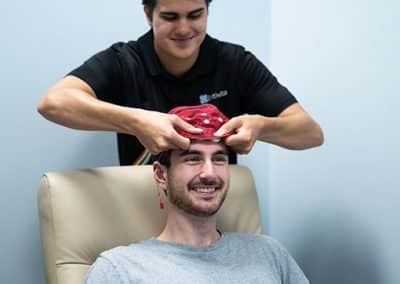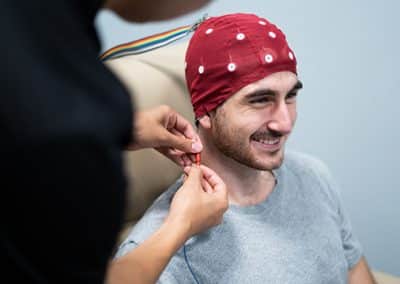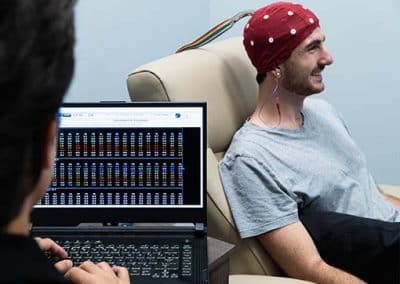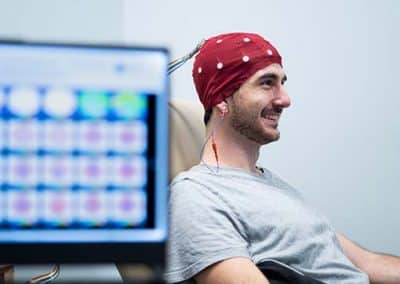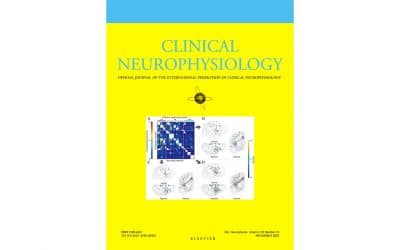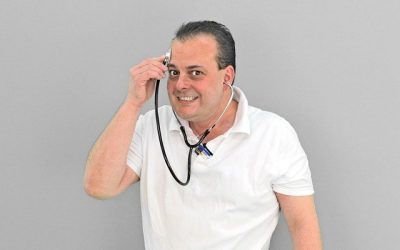Attention Deficit / Hyperactivity Disorder
Attention-Deficit/Hyperactivity Disorder (ADHD) is one of the most common neurodevelopmental disorders in the United States. It typically presents during childhood but persists through adolescence and adulthood in roughly 80% of ADHD cases(1). There are three types of ADHD: inattentive, hyperactive-impulsive, and combined. Individuals with inattentive presentation are easily distracted and forgetful. They have difficulty paying attention to tasks, may not be able to organize or finish a task, and can have issues following instructions. Hyperactive-impulsive individuals are often very fidgety and may talk over and interrupt others. They are typically restless, and have difficulty staying still for extended periods of time. Combined presentation is when both inattentive and hyperactive-impulsive characteristics present equally(2).
Treatment for ADHD typically involves cognitive behavioral therapy (CBT) and medication. However, there are many individuals who don’t respond to either CBT or medication, and medication is only a short-term treatment that has many potential side effects(3). We strongly recommend neurofeedback therapy for those looking for an effective approach and long-lasting improvements.
Extivita Therapies for ADHD:
Extivita Therapies for Attention-Deficit / Hyperactivity Disorder (ADHD):

Neurofeedback

Hyperbaric Oxygen Therapy

Supplements
Neurofeedback Therapy for ADHD:
Neurofeedback protocols for ADHD typically train the brain to reduce theta activity and/or increase beta activity towards the front and center of the brain(7). Another common protocol is sensorimotor rhythm (SMR) training, which trains the brain to increase low beta activity (12-15Hz) in the center of the head(7). While these protocols can be used as a foundation in neurofeedback protocol development, there is no single protocol that will be effective for everyone with ADHD. A training protocol developed based on the individual’s EEG brain map, their clinical symptoms, and neurofeedback research is the most effective neurofeedback protocol for ADHD.
Common EEG Abnormalities in ADHD:
- Increased relative theta activity and decreased relative beta activity in the frontocentral lobes in children(4-6)
- Decreased relative alpha activity in children(5)
- Increased relative theta activity in adults(6-7)

Hyperbaric Oxygen Therapy for ADHD:
Hyperbaric oxygen therapy (HBOT) may help alleviate the symptoms of ADHD by decreasing inflammation in the brain(8-11). Recent studies have found elevated levels of inflammatory markers in people with ADHD, as well as a direct association between that inflammation and hyperactive/inattentive symptoms(11-13). By reducing such inflammation, HBOT may reduce the primary behavioral symptoms that those with ADHD experience.

Decreased Inflammation
News & Research for ADHD:
The worldwide prevalence of ADHD: is it an American condition?
Abstract Attention-deficit/hyperactivity disorder (ADHD) is a behavioral disorder that affects up to 1 in 20 children in the USA. The predominance of American research into this disorder over the past 40 years has led to the impression that ADHD is largely an American...
A review of electrophysiology in attention-deficit/hyperactivity disorder: I. Qualitative and quantitative electroencephalography
This article reviews the electroencephalography (EEG) literature in relation to attention-deficit/hyperactivity disorder (AD/HD). The review briefly outlines the history of the disorder, focusing on the changing diagnostic systems which both reflect and constrain research into AD/HD. Both qualitative and quantitative EEG studies are examined, and their results are discussed in relation to various models of AD/HD. Implications of these data for future research and development in AD/HD are considered.
Specificity of quantitative EEG analysis in adults with attention deficit hyperactivity disorder
Abstract Attention deficit hyperactivity disorder (ADHD) in children and adolescents is characterised by excessive restlessness and an extremely poor concentration span, resulting in impulsive and disruptive behaviour. Clinical observation of ADHD in adults suggests...
References
- Faraone, Stephen V., et al. “The Worldwide Prevalence of ADHD: Is It an American Condition?” World Psychiatry, vol. 2, no. 2, June 2003, pp. 104–13.
- CDC. “What Is ADHD?” Centers for Disease Control and Prevention, 21 Sept. 2020, https://www.cdc.gov/ncbddd/adhd/facts.html.
- Budur, Kumar, et al. “Non-Stimulant Treatment for Attention Deficit Hyperactivity Disorder.” Psychiatry (Edgmont), vol. 2, no. 7, July 2005, pp. 44–48.
- Lenartowicz, Agatha, and Sandra K. Loo. “Use of EEG to Diagnose ADHD.” Current Psychiatry Reports, vol. 16, no. 11, Nov. 2014, p. 498. PubMed Central, doi:10.1007/s11920-014-0498-0.
- Barry, Robert J., et al. “A Review of Electrophysiology in Attention-Deficit/Hyperactivity Disorder: I. Qualitative and Quantitative Electroencephalography.” Clinical Neurophysiology: Official Journal of the International Federation of Clinical Neurophysiology, vol. 114, no. 2, Feb. 2003, pp. 171–83. PubMed, doi:10.1016/s1388-2457(02)00362-0.
- Lubar, J. F. “Discourse on the Development of EEG Diagnostics and Biofeedback for Attention-Deficit/Hyperactivity Disorders.” Biofeedback and Self-Regulation, vol. 16, no. 3, Sept. 1991, pp. 201–25. PubMed, doi:10.1007/BF01000016.
- Bresnahan, Susan M., and Robert J. Barry. “Specificity of Quantitative EEG Analysis in Adults with Attention Deficit Hyperactivity Disorder.” Psychiatry Research, vol. 112, no. 2, Oct. 2002, pp. 133–44. ScienceDirect, doi:10.1016/S0165-1781(02)00190-7.
- Benson, R. M., et al. “Hyperbaric Oxygen Inhibits Stimulus-Induced Proinflammatory Cytokine Synthesis by Human Blood-Derived Monocyte-Macrophages.” Clinical and Experimental Immunology, vol. 134, no. 1, Oct. 2003, pp. 57–62. PubMed Central, doi:10.1046/j.1365-2249.2003.02248.x.
- Lin, Kao-Chang, et al. “Attenuating Inflammation but Stimulating Both Angiogenesis and Neurogenesis Using Hyperbaric Oxygen in Rats with Traumatic Brain Injury.” The Journal of Trauma and Acute Care Surgery, vol. 72, no. 3, Mar. 2012, pp. 650–59. PubMed, doi:10.1097/TA.0b013e31823c575f.
- Godman, Cassandra A., et al. “Hyperbaric Oxygen Treatment Induces Antioxidant Gene Expression.” Annals of the New York Academy of Sciences, vol. 1197, June 2010, pp. 178–83. PubMed, doi:10.1111/j.1749-6632.2009.05393.x.
- Alvarez-Arellano, Lourdes, et al. “Antioxidants as a Potential Target against Inflammation and Oxidative Stress in Attention-Deficit/Hyperactivity Disorder.” Antioxidants, vol. 9, no. 2, 2, Multidisciplinary Digital Publishing Institute, Feb. 2020, p. 176. www.mdpi.com, doi:10.3390/antiox9020176.
- Dunn, Geoffrey A., et al. “Neuroinflammation as a Risk Factor for Attention Deficit Hyperactivity Disorder.” Pharmacology Biochemistry and Behavior, vol. 182, July 2019, pp. 22–34. ScienceDirect, doi:10.1016/j.pbb.2019.05.005.
- Oades, Robert D., et al. “Attention-Deficit Hyperactivity Disorder (ADHD) and Glial Integrity: An Exploration of Associations of Cytokines and Kynurenine Metabolites with Symptoms and Attention.” Behavioral and Brain Functions, vol. 6, no. 1, June 2010, p. 32. BioMed Central, doi:10.1186/1744-9081-6-32.

